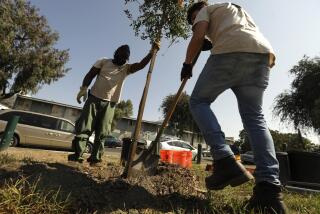Hoping to Add Lots of Green to Orange County
- Share via
Maybe it comes as no surprise that politically correct Santa Monica is about to distribute a map that inventories every green resource in the area--right down to school cafeterias that serve vegetarian entrees.
But could such a thing happen in development-driven Orange County? A group of area preservationists has faith that it will.
They are following Santa Monica’s lead in drafting a “green map” that they hope will be endorsed by county officials.
The Orange County project is geared more toward influencing the planning process and helping environmentalists to network, rather than creating a user-friendly guide to the area. Santa Monica’s map is full of informational nuggets and legends and icons--almost like an AAA trip guide--and is geared toward educating residents and tourists.
But both projects are evidence that the international green mapping movement, which has taken off in 135 communities in 35 countries, has arrived in Southern California. The point: to get the public and politicians thinking in terms of green.
“We’re trying to show the connectivity of these resources,” said Marilyn Ganahl, who is working on the Orange County green map project, launched and funded by Friends of Harbors, Beaches and Parks.
The group recently drafted an early version of its map, a collage of bold greens, soft purples, bright oranges and dull grays. It is a bird’s-eye view of all the major parks and open space in the county; the major watersheds that environmentalists are fighting to protect; the places where battles to preserve land are going on; and the parcels on wish lists for preservation efforts.
Gray equals “cemented over” in the language of these map makers. In civilian terms, “developed.”
The vivid colors mark established and potential greenbelts and wildlife corridors, along with waterways that extend from deep within inland canyons out to the ocean.
When placed together on a map, environmentalists say, the information becomes a persuasive picture that is much more effective in explaining their message than another plea about endangered animals, water quality and coastal sage scrub would be.
“This helps with land planning,” Ganahl said. “It helps people see what other groups are doing. . . . There are lots of stories in this map.”
The map offers a crash course in Orange County preservation. Scant color appears in the northern end of the county--just pockets here and there. The south is full of preserved land and of properties that still could be preserved, and blotches marking ongoing battles at places such as the 25,000 acres where Rancho Mission Viejo plans to build 14,000 homes.
The mapping process typically involves a cross-section of the community, from school groups to business leaders to local officials. Projects can use sophisticated global positioning technology and high-tech design equipment or be as simple as locating resources and pasting icons on a map.
“We want the maps to be an authentic expression of what is going on in a community,” said Wendy Brawer, director of the Greenmap System. “It is a way for people to see that urban planning is up to them as citizens.”
Santa Monica will unveil its city-funded green map at a Patagonia store next month, and will distribute more than 10,000 free copies to the public. The extensive icons on the two-sided, foldable final product identify everything from school cafeterias with organic meals to the Ballona Sand Dunes. Then there are migratory patterns, wetlands and native vegetation hot spots.
Isabelle Duvivier coordinated the project, enlisting extensive research help from Santa Monica High School students. Local officials wanted to limit the map to the borders of the city, but Duvivier expanded the project to include the Ballona watershed, which extends into Hollywood, Silver Lake and Culver City.
“Birds and pollution don’t know the boundaries of the city,” she said.
During the course of their research, Duvivier and the students located a new green corridor connecting three large chunks of open space between Santa Monica and Venice.
But it turned out that the corridor’s lush green golf courses and cemeteries--which had seemed ideal stopping-off points for birds--attracted few of them.
“We hypothesized [that] it was because the groundskeepers used chemicals the birds don’t like,” Duvivier said. So they made note of that for the map.
“We’re trying to educate people,” she said. “They usually don’t realize that if they dump a cigarette in Hollywood, it winds up in the Santa Monica Bay.”
More to Read
Sign up for Essential California
The most important California stories and recommendations in your inbox every morning.
You may occasionally receive promotional content from the Los Angeles Times.














